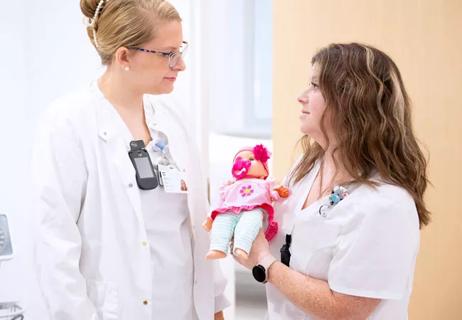Alzheimer’s, Lewy body and other etiologies have distinct presentations and treatments
Dementia is diagnosed based on presenting features that differentiate Alzheimer’s, Lewy body, Parkinson’s, frontotemporal and vascular etiologies, as well as reversible causes such as hypothyroidism and normal pressure hydrocephalus.
Cleveland Clinic is a non-profit academic medical center. Advertising on our site helps support our mission. We do not endorse non-Cleveland Clinic products or services. Policy
“It’s a transformative time in this field,” says neurologist Marwan Sabbagh, MD, a dementia expert at Cleveland Clinic Lou Ruvo Center for Brain Health. “Alzheimer’s disease has gone from a diagnosis of exclusion to a diagnosis of inclusion. The recent introduction of the PrecivityAD™ test, which measures the amyloid beta 42/40 ratio, has helped boost diagnostic accuracy above 90%. That’s remarkably precise.”
In the newest episode of Cleveland Clinic’s Neuro Pathways podcast, Dr. Sabbagh explains more about differential diagnosis in dementia. He highlights:
Click the podcast player above to listen to the 17-minute episode now, or read on for a short edited excerpt. Check out more Neuro Pathways episodes at clevelandclinic.org/neuropodcast or wherever you get your podcasts.
Dr. Sabbagh: Lewy body dementia is much more common than most people think. It’s the second most common dementia after Alzheimer’s. A million people in the United States have it. It has a very distinctive clinical phenotype of fluctuation, meaning patients have good days and bad days.
These patients have parkinsonism — mostly gait and a little tremor. They have their cognitive and motor declines coming on roughly around the same time, within a year of each other.
They have big-time visual hallucinations. So, if I see a patient with well-described visual hallucinations, I look for Lewy body first and Alzheimer’s second, because well-described visual hallucinations is one of the telltale signs of Lewy body dementia.
The last thing is that these patients act out dreams. So, if you have a patient who has a sleep study showing REM behavioral disturbance, they have synucleinopathy. Either they’re going to get Lewy body or they’re going to get Parkinson’s.
…I also see a lot of patients with suspected frontotemporal dementia. These are young people — under the age of 65 or even 60. There are two presentations: a behavioral variant and a language variant (aphasia). Remember, aphasia can be acquired or degenerative. Acquired means due to stroke or head injury. Degenerative means primary progressive aphasia, one of the subtypes of frontotemporal dementia. But the classic one that everybody knows is Pick’s disease. That’s the one that is a behavioral variant. These patients have impulsivity, socially inappropriate behavior. They’re out of control. These patients are very, very difficult to manage, and medicines don’t work very well.
Alzheimer’s is, of course, the big daddy of them all, constituting two-thirds of all dementia. If you actually went back and looked at autopsy, up to 75% of everybody with dementia has plaques and tangles in their brain. Most of them are overlaps with synuclein deposits in the brain and vascular changes. But Alzheimer’s, in its classic iteration, is a progressive amnestic disorder and has functional impairment that comes along with it. In the moderate stage, you start to see the emergence of neuropsychiatric features, the agitation, the wandering, the restlessness, the paranoia. It has a very distinctive phenotype.

Pilot study confirms feasibility of conducting additional research on the novel treatment

Longer hospitalization does not mean a safer, faster recovery for patients age 70+

Structured data helps identify older adults at risk for poor outcomes, defines patients who require more comprehensive assessments

Self-administered tool can be completed in 10 minutes in waiting room

Social prescribing turns leisure activities into good “medicine”

A large geriatric study aims to find the answers

Analysis underscores how telehealth can help pinpoint elder abuse